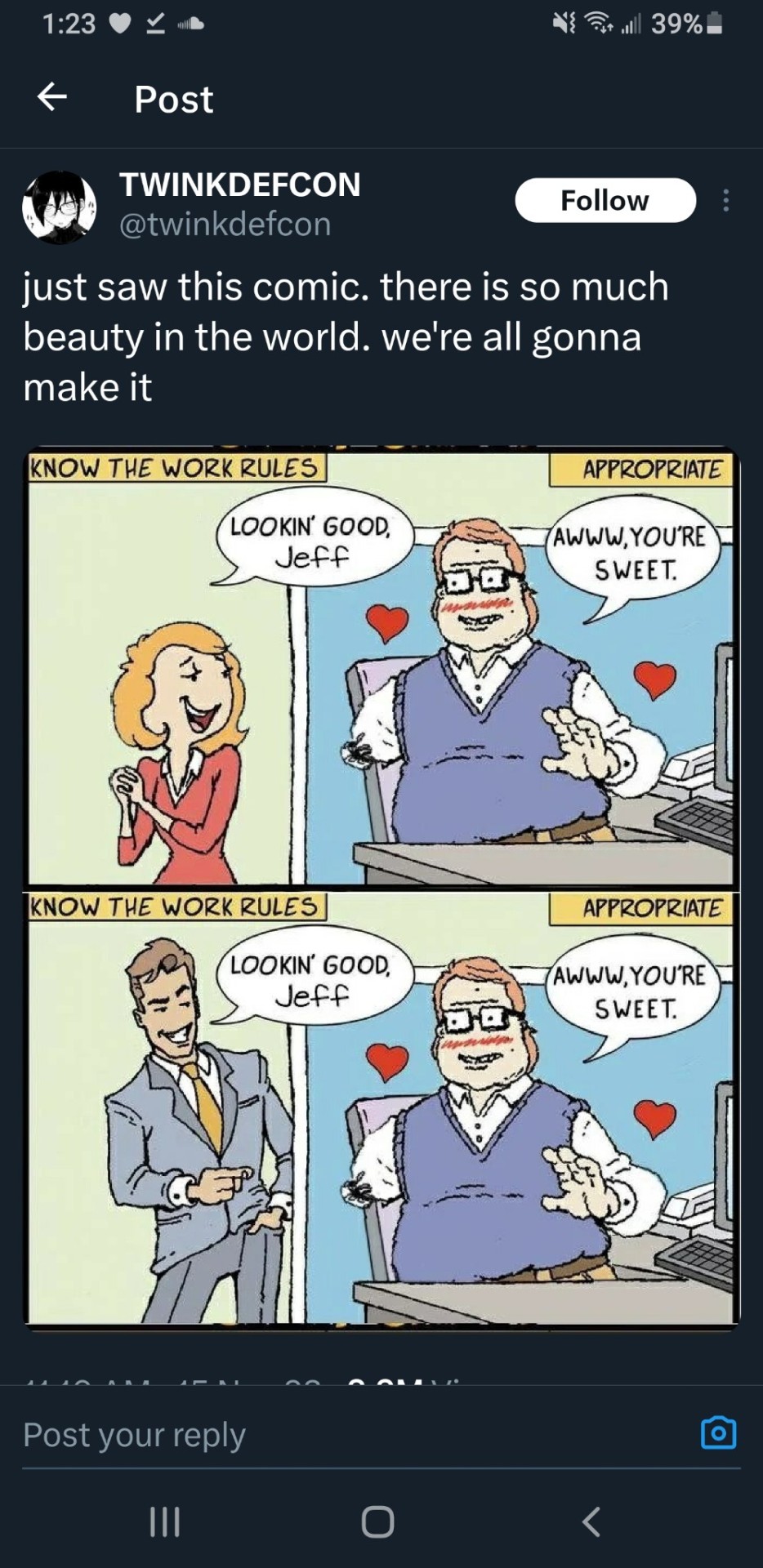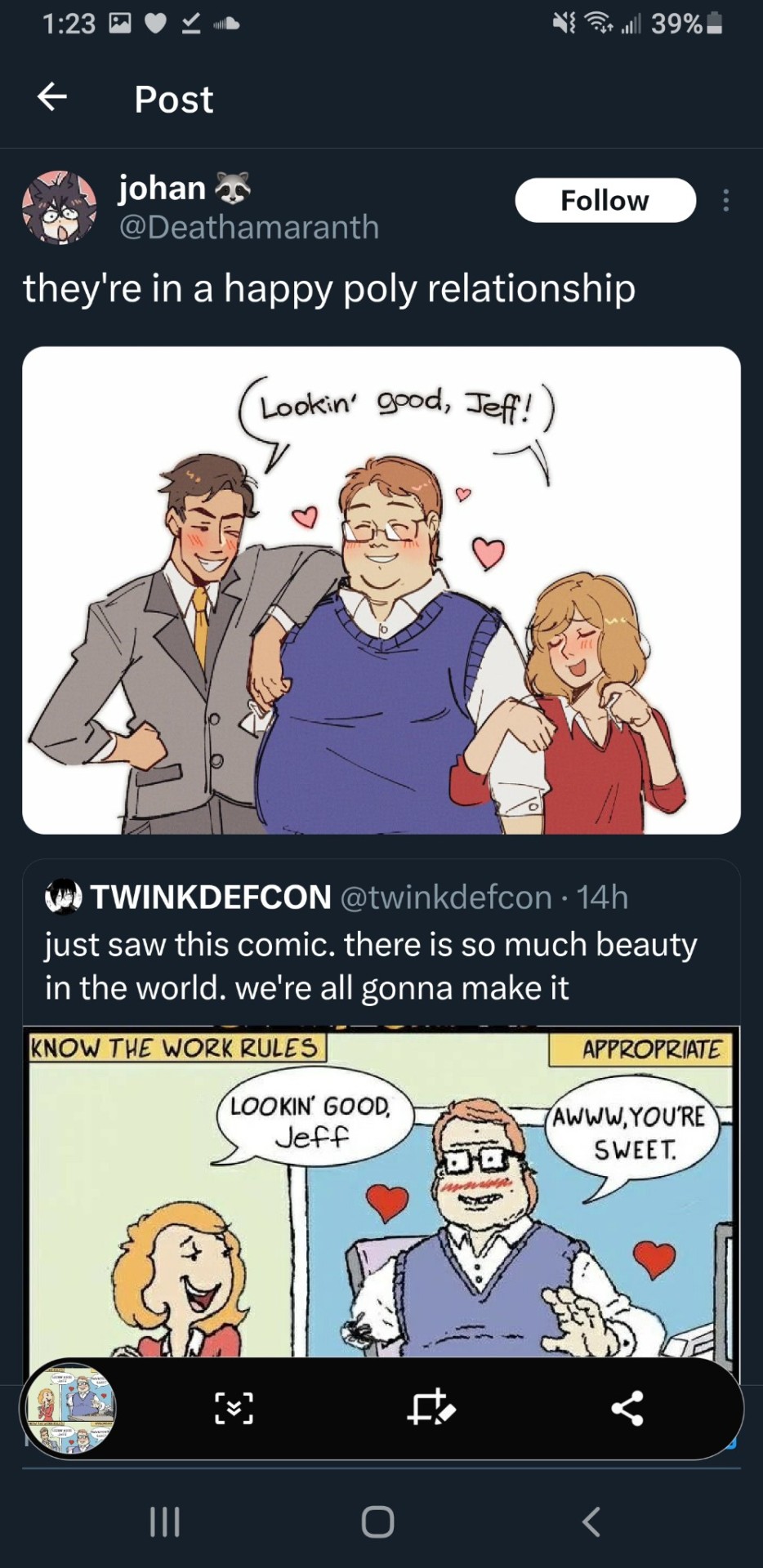(He/him) This blog is mostly dead. If you're reading this, it's likely because you're interacting with Mossworth. That's basically the main blog, now. Link: The Tavernkeep Says Hello (Everything blog): https://mossworth.tumblr.com/
Last active 2 hours ago
Don't wanna be here? Send us removal request.
Text
Adobe is going to spy on your projects. This is insane.
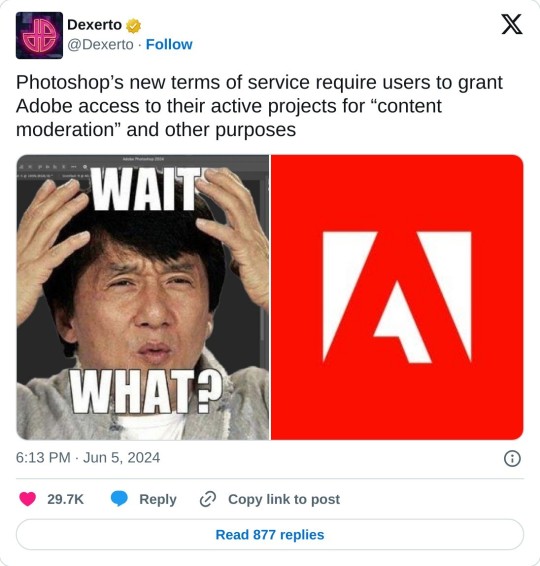

160K notes
·
View notes
Text
"With Donald Trump set to take office after a fear-mongering campaign that reignited concerns about his desire to become a dictator, a reasonable question comes up: Can nonviolent struggle defeat a tyrant?
There are many great resources that answer this question, but the one that’s been on my mind lately is the Global Nonviolent Action Database, or GNAD, built by the Peace Studies department at Swarthmore College. Freely accessible to the public, this database — which launched under my direction in 2011 — contains over 1,400 cases of nonviolent struggle from over a hundred countries, with more cases continually being added by student researchers.
At quick glance, the database details at least 40 cases of dictators who were overthrown by the use of nonviolent struggle, dating back to 1920. These cases — which include some of the largest nations in the world, spanning Europe, Asia, Africa and Latin America — contradict the widespread assumption that a dictator can only be overcome by violence. What’s more, in each of these cases, the dictator had the desire to stay, and possessed violent means for defense. Ultimately, though, they just couldn’t overcome the power of mass nonviolent struggle.
In a number of countries, the dictator had been embedded for years at the time they were pushed out. Egypt’s Hosni Mubarak, for example, had ruled for over 29 years. In the 1990s, citizens usually whispered his name for fear of reprisal. Mubarak legalized a “state of emergency,” which meant censorship, expanded police powers and limits on the news media. Later, he “loosened” his rule, putting only 10 times as many police as the number of protesters at each demonstration.
The GNAD case study describes how Egyptians grew their democracy movement despite repression, and finally won in 2011. However, gaining a measure of freedom doesn’t guarantee keeping it. As Egypt has shown in the years since, continued vigilance is needed, as is pro-active campaigning to deepen the degree of freedom won.
Some countries repeated the feat of nonviolently deposing a ruler: In Chile, the people nonviolently threw out a dictator in 1931 and then deposed a new dictator in 1988. South Koreans also did it twice, once in 1960 and again in 1987. (They also just stopped their current president from seizing dictatorial powers, but that’s not yet in the database.)
In each case people had to act without knowing what the reprisals would be...
It’s striking that in many of the cases I looked at, the movement avoided merely symbolic marches and rallies and instead focused on tactics that impose a cost on the regime. As Donald Trump wrestles to bring the armed forces under his control, for example, I can imagine picketing army recruiting offices with signs, “Don’t join a dictator’s army.”
Another important takeaway: Occasional actions that simply protest a particular policy or egregious action aren’t enough. They may relieve an individual’s conscience for a moment, but, ultimately, episodic actions, even large ones, don’t assert enough power. Over and over, the Global Nonviolent Action Database shows that positive results come from a series of escalating, connected actions called a campaign...
-via Waging Nonviolence, January 8, 2025. Article continues below.
East Germany’s peaceful revolution
When East Germans began their revolt against the German Democratic Republic in 1988, they knew that their dictatorship of 43 years was backed by the Soviet Union, which might stage a deadly invasion. They nevertheless acted for freedom, which they gained and kept.
Researcher Hanna King tells us that East Germans began their successful campaign in January 1988 by taking a traditional annual memorial march and turning it into a full-scale demonstration for human rights and democracy. They followed up by taking advantage of a weekly prayer for peace at a church in Leipzig to organize rallies and protests. Lutheran pastors helped protect the organizers from retaliation and groups in other cities began to stage their own “Monday night demonstrations.”
The few hundred initial protesters quickly became 70,000, then 120,000, then 320,000, all participating in the weekly demonstrations. Organizers published a pamphlet outlining their vision for a unified German democracy and turned it into a petition. Prisoners of conscience began hunger strikes in solidarity.
By November 1988, a million people gathered in East Berlin, chanting, singing and waving banners calling for the dictatorship’s end. The government, hoping to ease the pressure, announced the opening of the border to West Germany. Citizens took sledgehammers to the hated Berlin Wall and broke it down. Political officials resigned to protest the continued rigidity of the ruling party and the party itself disintegrated. By March 1990 — a bit over two years after the campaign was launched — the first multi-party, democratic elections were held.
Students lead the way in Pakistan
In Pakistan, it was university students (rather than religious clerics) who launched the 1968-69 uprising that forced Ayub Khan out of office after his decade as a dictator. Case researcher Aileen Eisenberg tells us that the campaign later required multiple sectors of society to join together to achieve critical mass, especially workers.
It was the students, though, who took the initiative — and the initial risks. In 1968, they declared that the government’s declaration of a “decade of development” was a fraud, protesting nonviolently in major cities. They sang and marched to their own song called “The Decade of Sadness.”
Police opened fire on one of the demonstrations, killing several students. In reaction the movement expanded, in numbers and demands. Boycotts grew, with masses of people refusing to pay the bus and railway fares on the government-run transportation system. Industrial workers joined the movement and practiced encirclement of factories and mills. An escalation of government repression followed, including more killings.
As the campaign expanded from urban to rural parts of Pakistan, the movement’s songs and political theater thrived. Khan responded with more violence, which intensified the determination among a critical mass of Pakistanis that it was time for him to go.
After months of growing direct action met by repressive violence, the army decided its own reputation was being degraded by their orders from the president, and they demanded his resignation. He complied and an election was scheduled for 1970 — the first since Pakistan’s independence in 1947.
Why use nonviolent struggle?
The campaigns in East Germany and Pakistan are typical of all 40 cases in their lack of a pacifist ideology, although some individuals active in the movements had that foundation. What the cases do seem to have in common is that the organizers saw the strategic value of nonviolent action, since they were up against an opponent likely to use violent repression. Their commitment to nonviolence would then rally the masses to their side.
That encourages me. There’s hardly time in the U.S. during Trump’s regime to convert enough people to an ideological commitment to nonviolence, but there is time to persuade people of the strategic value of a nonviolent discipline.
It’s striking that in many of the cases I looked at, the movement avoided merely symbolic marches and rallies and instead focused on tactics that impose a cost on the regime. As Donald Trump wrestles to bring the armed forces under his control, for example, I can imagine picketing army recruiting offices with signs, “Don’t join a dictator’s army.”
Another important takeaway: Occasional actions that simply protest a particular policy or egregious action aren’t enough. They may relieve an individual’s conscience for a moment, but, ultimately, episodic actions, even large ones, don’t assert enough power. Over and over, the Global Nonviolent Action Database shows that positive results come from a series of escalating, connected actions called a campaign — the importance of which is also outlined in my book “How We Win.”
As research seminar students at Swarthmore continue to wade through history finding new cases, they are digging up details on struggles that go beyond democracy. The 1,400 already-published cases include campaigns for furthering environmental justice, racial and economic justice, and more. They are a resource for tactical ideas and strategy considerations, encouraging us to remember that even long-established dictators have been stopped by the power of nonviolent campaigns.
-via Waging Nonviolence, January 8, 2025.
5K notes
·
View notes
Text
Another thing I've noticed working as a children's librarian is like... kids get so Paralyzed By Choice and the adults in their lives never really register why. Like, for example, we have little scavenger hunt sheets in the children's section and when a kid completes it, they get to pick out a cute eraser from our prize basket. We also have a little toy prize chest as part of our "1000 books before Kindergarten" challenge for when kids complete 100 books--and kids will spend minutes carefully picking through everything while their parents are shooting us anxious looks like "sorry they're taking so long! I know this is silly and it's completely ridiculous that my child is taking so long to choose between a bath toy and a cube puzzle because these are cheap and arbitrary objects! Hurry up, Harper! Just pick something! You're embarrassing me!!" But in the kids' perspective, they already have so little control over what objects come into their lives, and in this case, the object represents labor and effort on their end, so of course they feel they must choose very carefully. I've always been an anxious and indecisive person, so it's striking to see how being rushed really doesn't help that and really only makes it harder for kids to figure out what they want.
80K notes
·
View notes
Text


Jason breathed, calming himself - then, turning to try and calm the man bound to the surgery chair in front of him. "Taxi? Listen to me. You're going through what's called a psychological regression. You've woken up in a place and a situation that you don't recognize, so your brain is trying to make sense of it with what it has. Whatever danger you think you're in is old. It's not what's happening." Taxi looked to him, obstinence hiding his fear, "Who the fuck are you?" "Taxi, I'm your mate. Your friend."
A laugh escaped him, dark and throaty, an intensity in his face that Jason had never seen, as mild as he so often was. It was frightening - the gleam of a cornered animal's teeth. Where in that head if his, confused as it was, did he feel he would be allowed the comfort of a friend? "My mate?" He spat, "You don't even know my name."
It was true. He didn't. Obviously, he had not been named Taxi Driver back in China, or Poland or whichever place he had claimed to be from. But it was the fact that he had never asked which proved he was ever a true friend at all.
Taxi Driver had emergency brain surgery and it made him a worse person [temporarily]! And then became a very scared person once he came back to his own head [long-term]!
#cyberpunk red#scenes from in-game#cyberpunk 2047#cyberpunk#cyberpunk 2077#cyberpunk art#cyberpunk tabletop#CPR#cyberpunk oc#oc#digital art#ocs#Taxi Driver#Jason Buckingham#tabletop roleplaying#tabletop#tabletop art#please ask for more context I am so willing to give more context#also ignore my side blog logo there I didnt know where I was going to post this when I needed to put down a signature
5 notes
·
View notes
Text
if you are unable to donate financially to help palestine, you can donate your time by protesting, boycotting, and putting up posters!
if all you have is your device and internet access, you can put your clicks to good use on arab.org. they use the advertising revenue generated by your clicks to help good causes.
and i would urge those able to spare a few dollars to donate to one or more of the following organizations:
eSims for Gaza
Direct aid for Gaza
Care for Gaza
Women for Women International
Institute for Middle East Understanding
Medical Aid for Palestinians
Palestine Children Relief Fund
Muslim Aid USA
Direct Aid for Gaza
Palestinian American Medical Association
Urgent support for medical professionals in Gaza
Emergency Relief for Gaza
Anera
Taawon
58K notes
·
View notes
Text

🇵🇸 From BDS - What to Boycott:
Fruits, vegetables and wines from Israel are often wrongly labelled as “Produce in Israel” when they come from stolen Palestinian land. Boycott all produce from Israel in your supermarket and demand they are removed from shelves.
thank you @leandra-winchester for making the graphic above! if any of you are active on other social platforms, you have her permission to use the image however you want (no credit required)
keep in mind, though, that this isn't a complete list: you should still check the origin labels on other types of fruit and veggies, and see if any local orgs have produced a more complete breakdown of israeli produce that's specific to your country
30K notes
·
View notes
Text

“Rather odd for Lord Tailon to request time alone right before tea,,, it may get cold- s-start another pot.”
Ovid (Left) belongs to @stragglewort , Tailon (Right) is my own
[Full below,,, if tumblr allows]
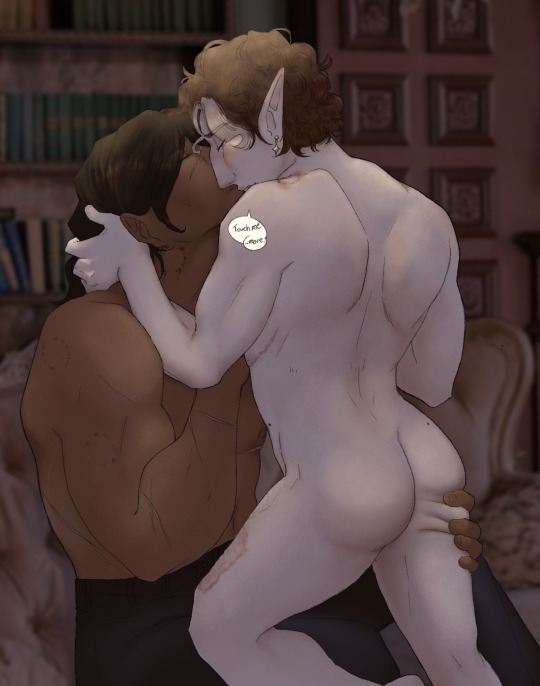
#tailon whithell#ovid of house whithell#ocs#t4t#digital art#friend's art#my oc#friend's oc#pretty vampire man#tailon#ovid
5 notes
·
View notes
Text
so, you wanted to start bookbinding?
so @princetofbone mentioned on my post for "factory settings" about wanting to know more about the binding style that i used for it. so i thought i might make a post about it.
i was as terrible as i always am for taking in progress shots, but i can link you to the resources i used in order to make my book. i would also like to point out that "factory settings" is my 120th bind, and i have been doing bookbinding as a hobby for just over 3 years now. unfortunately this means some of the methods that i used for that bind aren't particularly beginner friendly, just in terms of the tools and methods i have used, but i would love to point you in the right direction when it comes to resources. i dont say this to sound pretentious which i fear i might come across, just so that youre fully informed. getting into this hobby is fun and rewarding, but it can definitely be intimidating.
with that caveat, heres a list of links and resources that i have used for bookbinding in general, with additional links to methods i used specifically in regards to this bind.
ASH's how to make a book document. it gives you a great introduction into typesetting fics (where you format the text of fics to look like a traditionally published books) and then turning them into a case-bound book (the style i used for "factory settings"). it is comprehensive, and explains how to use microsoft word to do your bidding. it was invaluable to me when i was just starting out! currently i use affinity publisher to typeset/format my fics for printing, but i only bought and learned how to use that after i had been binding books for a year and a half. i made some beautiful typesets with word, and some of my close friends use it still and design stuff that i never would be able to in my wildest dreams (basically anything by @no-name-publishing)
DAS Bookbinding's Square Back Bradel Binding. a great style to do your first bind in! this method requires, when making the case, to attach the cover board and the spine board to a connecting piece of paper, which makes it so much easier to match the size of the case to the size of the text block (your printed out and sewn fic). using this method is what allowed me to get much more accurately fitting cases, and made me much more confident with the construction of the books i was making. a well-made book is something that is so wonderful to hold in your hands!
DAS Bookbinding's Rounded and Backed Cased Book. This is the specific method that i used to create my bind for "factory settings"! even before i could back my books, i found that watching DAS's videos in particular helped me see how books were traditionally made, and i was able to see different tips and tricks about how to make nicer books.
Book Edge Trimming Without... i trim the edges of my text block using my finishing press and a chisel i have sharpened using a whetstone and leather strop with buffing compound on it. i follow the method for trimming shown in this video!
Made Endpapers. i follow this method for my endpapers, as i used handmade lokta endpapers, and they can be quite thin, but they look beautiful! i used "tipped on" endpapers (where you have your endpaper and then put a thin strip of glue on the edge and attach it to your text block) i used for a very long time before this, but these feel like they are much more stable, as they are sewn with your text block.
Edge Sprinkling. this is the method that i used for decorating the edges of my text block. but the principle is basically clamping your text block tight and then sprinkling the edges. i do not believe you need to trim the edges in order to do sprinkles on the edges, and that's what makes it accessible! i personally just use really cheap acrylic paint that i water down and then flick it onto the edges with my thumb and a paint brush.
Double-Core Endbands. i sew my own endbands, which i followed this tutorial for. that being said, it's kind of confusing, and this video is a bit easier to follow, but it is a slightly different type of endband.
Case decoration. i used my silhouette cameo 4 to cut out my design for "factory settings" in htv (heat transfer vinyl). i also used my cameo 4 to cut out the oval of marbled paper on the front, as i honestly didn't want to try my hand at cutting an oval lol. i also glued some 300 gsm card with an oval cut out of the centre of it onto the cover before covering it with bookcloth, to get a kind of recess on the cover. i then glued the oval of marbled paper onto the top of the recessed area once it was covered with bookcloth, so that it was protected. the images i used were sourced from a mix of rawpixel, canva and pixabay. a more accessible way to get into cover decoration is by painting on a design for your cover as described in @a-gay-old-time's tutorial just here. or even doing paper labels, which look classy imo.
physical materials. sourcing these will depend on your country. i am located in australia, and have compiled a list with some other aussie bookbinders of places to buy from. here is a great post describing beginning materials for getting started binding.
@renegadepublishing. this tumblr is great! its what got me started bookbinding, and being in the discord has been inspiring, motivating, and honestly just one of the best online experiences i have ever had. it is full of resources, and most people in there are amateur bookbinders, with a couple of professionals thrown in. the discord is 18+, and anyone can join!
i'm sorry this post got so long, but i hope that this has a lot of information for you if you would like to get started bookbinding. its one of the best hobbies ive ever had, and i genuinely believe i will have it for the rest of my life.
4K notes
·
View notes
Note
any advice on making capes?
Ooh, I love capes!
Making capes
Types of capes:
There are different types of capes. Let's take a look at a few options.
Rectangle cape: the type of cape American superheroes wear. They consist out of a simple rectangle that can be tied or clasped at the neck. Use gathered fabric for extra fullness. This type of cape won't give you a lot of warmth as it will only cover your back.
Quarter circle cape: slightly more flared than a rectangle cape, but will still only cover your back.
Half circle cape: will cover both your back and shoulders and some of your body, which will give you extra warmth. Great for drama!
Fitted half circle cape: similar to a half circle cape, but made out of three separate pieces to fit around your body better. It won't cover you completely, but it will cover your back, shoulders, and more of your body than a normal half circle cape would.
Full circle cape: this cloak will cover your full body and keep you nice and warm.
Savvy sewists will notice these cape types are similar to circle skirts. The idea's basically the same. Instead of making a skirt, you leave your circle open in the front, and cut a hole that fits your neck rather than your waist.
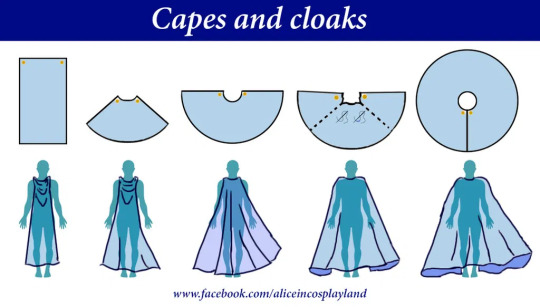
(Image source) [ID: drawing showing five types of coats: rectangle, quarter circle, half circle, half fitted circle, full circle. Text: "Capes and cloaks. www.facebook.com/aliceincosplayland".]
Aside of volume, you can also play around with length. A floor-length cape has a very different effect and function than a cape that reaches your hips, or even a capelet.
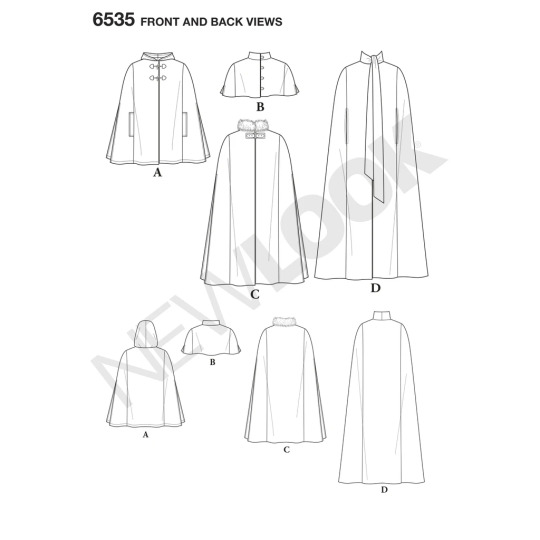
(Image source) [ID: a pattern diagram showing four different cape lengths: floor length, hip length, waist length, and a capelet. Text: "6535 Front and back views. Newlook."]
Details like a hood or armholes can make your cape extra comfortable, and you've got a wide range of options when it comes to fasteners, too.
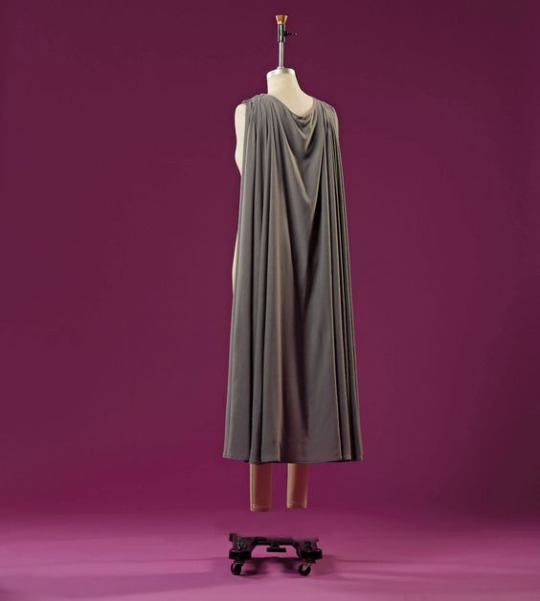
(Image source) [ID: back view of a long gray half circle cape that's been pleated at the shoulders.]
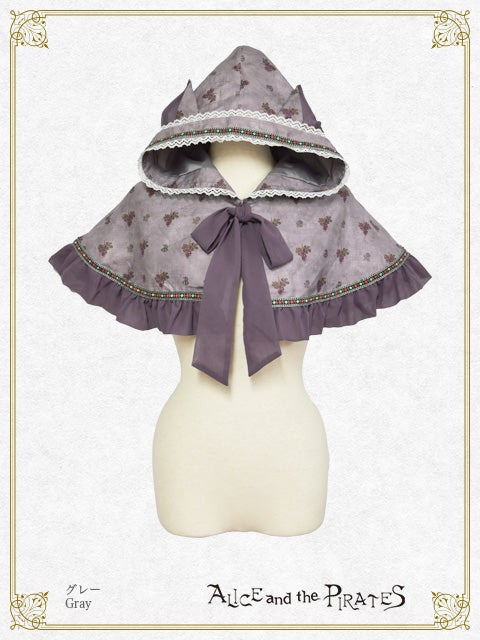
(Image source) [ID: a purple capelet with a hood, frills, cat ears, and lace, tied with a bow at the front. Text: "Gray. Alice and the Pirates."]
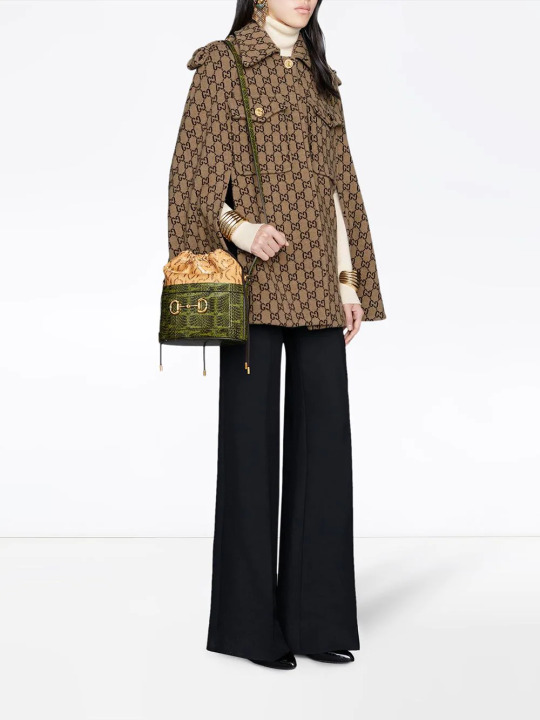
(Image source) [ID: a person wearing a brown monogrammed hip-length cape with front pockets and arm slits at the sides.]

(Image source) [ID: a person wearing a long gray hooded cape, standing in a forest and holding a sword.]
Materials:
Before deciding what fabrics to make your cloak or cape out of, ask yourself what you're trying to achieve first.
Warmth, drape, fabric price, comfort, aesthetic, wearing context,... are some examples of things that can influence your decision.
Some examples:
A cosplay cloak has to look good but doesn't necessarily have to be warm. Choose a fabric that's suitable for your character's outfit, but also keep the circumstances in which you plan to wear your outfit in mind. For example, a warm cloak might pose issues if you do a lot of indoor photo shoots, but convention halls can be pretty chilly.
A fashion cloak intended for winter really does need to be warm! Wool, tweed, and velvet are good options.
A cloak intended for historical re-enactment preferably uses period-accurate materials and therefore won't be lined with fabrics like polyester and such. Which fabric to use depends on the period and region you're working in.
Tutorials and patterns:
Here's a few tutorials/patterns to get you started:
Fitted cloak: winterberry cape (Mood)
How to draft your own hooded cape (The Spruce Crafts)
Pleated half circle cape (Gilian Conahan)
Half circle capelet (Buzzfeed)
Long hooded cloak (Fleece Fun)
Full circle capelet (Project Run and Play)
Four ways to make a cape (WikiHow)
Eight types of capes (Sew Guide)
Half circle fashion cape (Indoor Shannon)
21 free cape sewing patterns (Love Sewing)
Hooded cloak with lining (Online Fabric Store)
Conclusion:
Capes and cloaks make for fun sewing projects. They're pretty easy to make: if you know how to draw circles, you know how to draft a cape pattern.
Capes are a versatile garment, and can range from a great last-minute Halloween costume to an every-day winter cloak. Play around with materials, lengths, shapes, design elements, decoration,... to achieve different effects.
And most of all: have fun with it!
28K notes
·
View notes
Text
moodboard for writing a transition sentence or paragraph

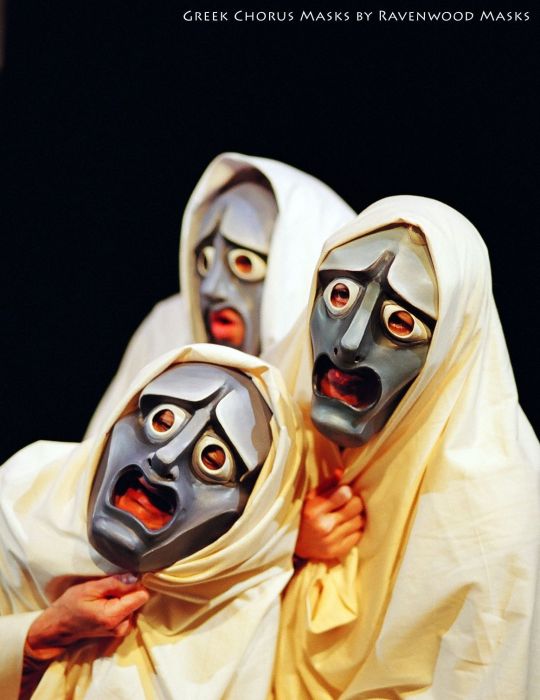

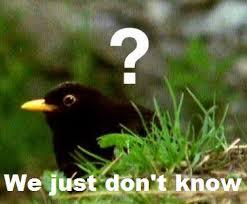
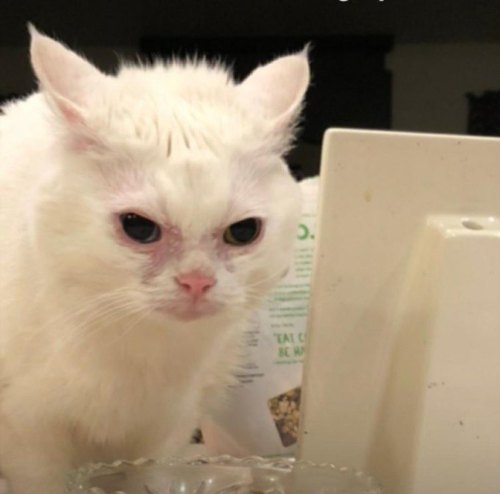

6K notes
·
View notes
Text
“Public libraries are such important, lovely places!” Yes but do you GO there. Do you STUDY there. Do you meet friends and get coffee there. Do you borrow the FREE, ZERO SUBSCRIPTION, ZERO TRACKING books, audiobooks, ebooks, and films. Have you checked out their events and schemes. Do you sign up for the low cost courses in ASL or knitting or programming or writing your CV that they probably run. Do you know they probably have myriad of schemes to help low income families. Do you hire their low cost rooms if you need them. Have you joined their social groups. Do you use the FREE COMPUTERS. Do you even know what your library is trying to offer you. Listen, the library shouldn’t just exist for you as a nice idea. That’s why more libraries shut every year
143K notes
·
View notes
Text
I work at a library Collection pt. 1

A story in few words



Yeah I think I remember bricks being a a whole thing in this story
61 notes
·
View notes
Text
waking up... prompts
in a stranger's apartment
accused of murder in a police department
in someone else's body
to a hand clamped over your mouth
and the clock reads yesterday
in your mother's arms
in a casket
in a hospital
and you're in a new country
and people have mistaken you for someone else
and people have mistaken you for a god
in a fire
feverish, but someone holds a cold towel to your forehead
in a yelling stranger's arms
in the middle of the road, headlights flashing
and you smell poison
in the villain's lair
kicking and screaming to someone with a knife in hand
and you've missed the battle
#its not an ask game but im turning it into one.#ask for an OC and I'll write it!#or I'll just do dealers choice#ask game
1K notes
·
View notes
Note
thank you for the updates on the print obscura saga, i'm glad it's finally over lol
one thing i don't understand is how multiple copies got printed? did someone do that or was it like a glitch or something?
It was a ghost.
I can only give my best guess, but it's a guess good enough that my manager is using it as the proper explanation. Any actual tech people please feel free to theorize, I just work here.
So the computers we have at my library after from a laptop kiosk, like a vending machine for computers. They look like this -

Well, the shtick with these kiosks is that the laptops are supposed to "wipe" themselves every time you shut it down. I learned recently that it's basically a virtual machine situation. It takes a snapshot of the computer and defaults to that snapshot every time it's turned off and reopened. Well SOMEONE, SOMEHOW managed to make the machine take a new default snapshot(?) At the exact moment the computer sent out a print signal to our printer to make a copy of, what we've all been seeing, the Candela Obscura quickstart guide.
So every time it would reset itself, on or off, being used or not (which, when it's put away, seems to happen in cycles multiple times a day? I guess?) It would send out a new signal for a copy of Candela Obscura. We've finally gotten the computer to default to a state where Candela Obscura isn't gone, but it is in the recycling bin, and cannot be printed.
That's the best we've managed to do.
That's the best answer I have.
But there's no proving any of that.
Anywho, despite all that I still think it's a ghost.
10 notes
·
View notes
Text
The candela obscura saga is over but the newest mystery is figuring out what's up with all the eyes.

The collection so far. (I actually threw a few of my own in there [blue looking up and yellow lookong down]. If you can't beat the omen, become part of it!)
We found it.
We actually found it.

The ghost was in Computer 9
39 notes
·
View notes
